Empowering Australia's Aged: A Report on Consumer Directed Care
VerifiedAdded on 2023/06/12
|11
|2599
|124
Report
AI Summary
This report provides an evaluation and analysis of Consumer Directed Care (CDC) within the Australian aged care sector. It explores how CDC empowers older individuals by giving them choice and control over their care services, including the type of service, service provider, and timing of care. The report discusses the positive aspects of CDC, such as closing the gap between different levels of care packages and increasing consumer responsibility, while also addressing challenges like co-payment burdens and potential difficulties in accessing services for disadvantaged groups. The responsibilities of service-providing organizations are also highlighted, emphasizing the need for updated care models, staff training, and modern IT systems to effectively implement CDC. The report concludes that while CDC empowers older people and gives them a voice, there is still room for improvement in ensuring equitable access and quality of care for all members of the aged community.
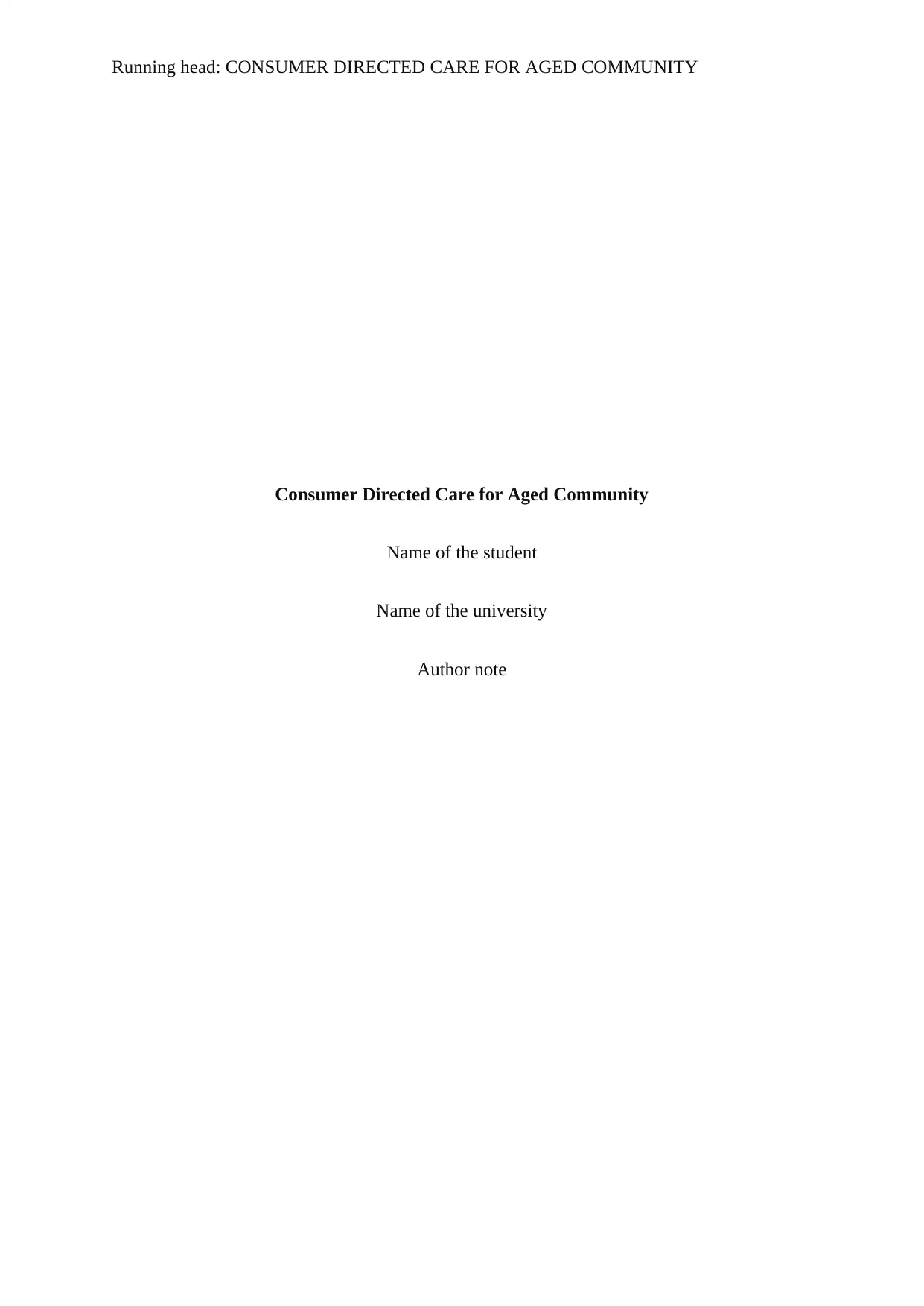
Running head: CONSUMER DIRECTED CARE FOR AGED COMMUNITY
Consumer Directed Care for Aged Community
Name of the student
Name of the university
Author note
Consumer Directed Care for Aged Community
Name of the student
Name of the university
Author note
Paraphrase This Document
Need a fresh take? Get an instant paraphrase of this document with our AI Paraphraser

1CONSUMER DIRECTED CARE FOR AGED COMMUNITY
Executive summary
The term consumer directed care is used to explain the process of service providing
that allows the aged people to make their own choices regarding the types of service they
want and who should be there to provide the services and when. It allows the consumers to
control the entire care service according to their choice and needs. Even though the case
managers may face challenges in changing the mindsets of people, in discussing the methods
of working and communicating, discussing the methods of the practice approaches, it would
be easier for them if different clients were provided with different levels of case management
interventions. The aim of this assessment is to evaluate the health systems that are used to
provide support to the older people and analyse the various ways it can empower the aged
community.
Executive summary
The term consumer directed care is used to explain the process of service providing
that allows the aged people to make their own choices regarding the types of service they
want and who should be there to provide the services and when. It allows the consumers to
control the entire care service according to their choice and needs. Even though the case
managers may face challenges in changing the mindsets of people, in discussing the methods
of working and communicating, discussing the methods of the practice approaches, it would
be easier for them if different clients were provided with different levels of case management
interventions. The aim of this assessment is to evaluate the health systems that are used to
provide support to the older people and analyse the various ways it can empower the aged
community.

2CONSUMER DIRECTED CARE FOR AGED COMMUNITY
Table of Contents
Introduction................................................................................................................................3
Discussion..................................................................................................................................3
Evaluation..............................................................................................................................3
Analysis..................................................................................................................................5
Positive aspects of CDC:....................................................................................................5
Challenges and concerns of CDC:.....................................................................................6
Conclusion..................................................................................................................................7
References..................................................................................................................................9
Table of Contents
Introduction................................................................................................................................3
Discussion..................................................................................................................................3
Evaluation..............................................................................................................................3
Analysis..................................................................................................................................5
Positive aspects of CDC:....................................................................................................5
Challenges and concerns of CDC:.....................................................................................6
Conclusion..................................................................................................................................7
References..................................................................................................................................9
⊘ This is a preview!⊘
Do you want full access?
Subscribe today to unlock all pages.

Trusted by 1+ million students worldwide
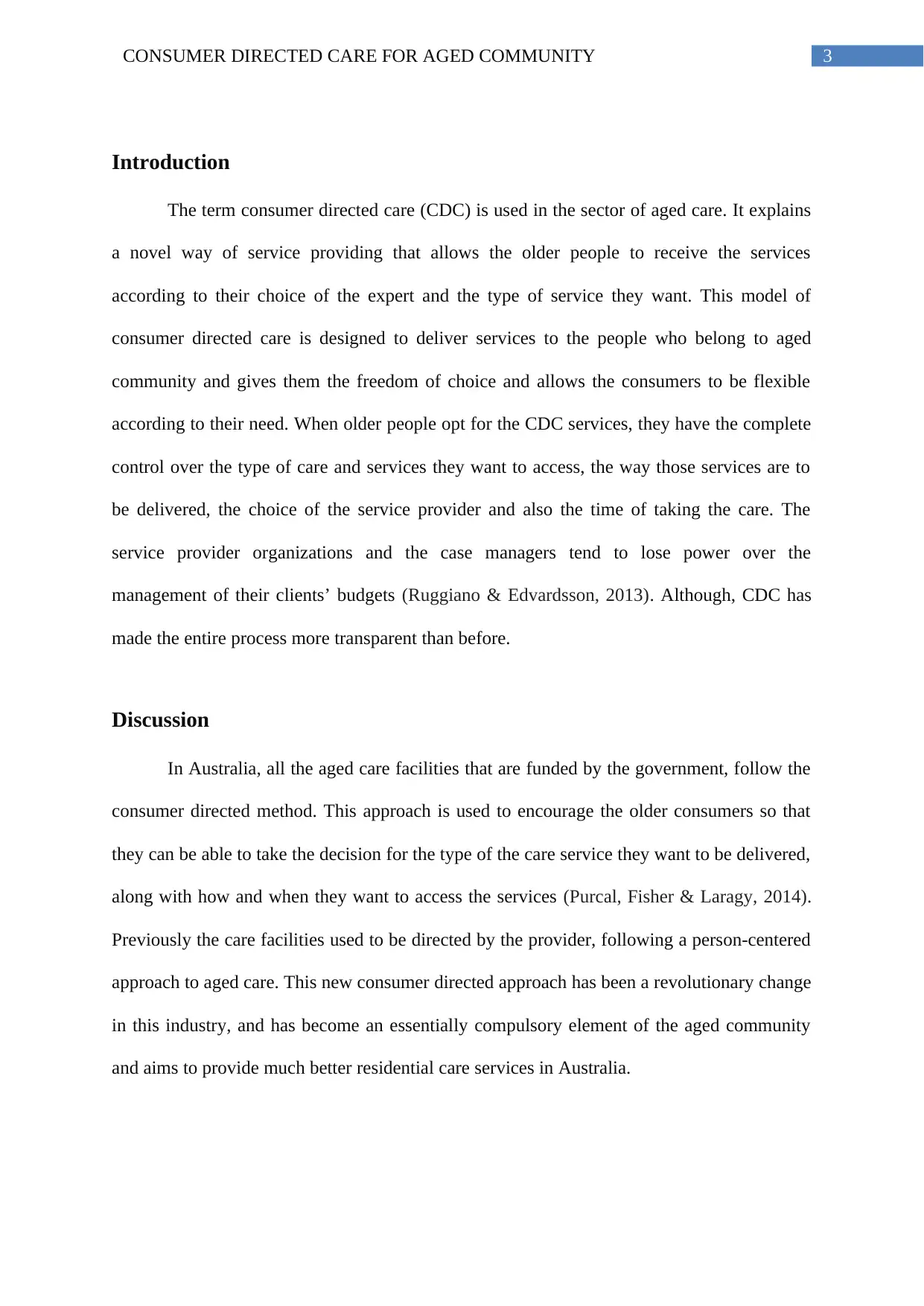
3CONSUMER DIRECTED CARE FOR AGED COMMUNITY
Introduction
The term consumer directed care (CDC) is used in the sector of aged care. It explains
a novel way of service providing that allows the older people to receive the services
according to their choice of the expert and the type of service they want. This model of
consumer directed care is designed to deliver services to the people who belong to aged
community and gives them the freedom of choice and allows the consumers to be flexible
according to their need. When older people opt for the CDC services, they have the complete
control over the type of care and services they want to access, the way those services are to
be delivered, the choice of the service provider and also the time of taking the care. The
service provider organizations and the case managers tend to lose power over the
management of their clients’ budgets (Ruggiano & Edvardsson, 2013). Although, CDC has
made the entire process more transparent than before.
Discussion
In Australia, all the aged care facilities that are funded by the government, follow the
consumer directed method. This approach is used to encourage the older consumers so that
they can be able to take the decision for the type of the care service they want to be delivered,
along with how and when they want to access the services (Purcal, Fisher & Laragy, 2014).
Previously the care facilities used to be directed by the provider, following a person-centered
approach to aged care. This new consumer directed approach has been a revolutionary change
in this industry, and has become an essentially compulsory element of the aged community
and aims to provide much better residential care services in Australia.
Introduction
The term consumer directed care (CDC) is used in the sector of aged care. It explains
a novel way of service providing that allows the older people to receive the services
according to their choice of the expert and the type of service they want. This model of
consumer directed care is designed to deliver services to the people who belong to aged
community and gives them the freedom of choice and allows the consumers to be flexible
according to their need. When older people opt for the CDC services, they have the complete
control over the type of care and services they want to access, the way those services are to
be delivered, the choice of the service provider and also the time of taking the care. The
service provider organizations and the case managers tend to lose power over the
management of their clients’ budgets (Ruggiano & Edvardsson, 2013). Although, CDC has
made the entire process more transparent than before.
Discussion
In Australia, all the aged care facilities that are funded by the government, follow the
consumer directed method. This approach is used to encourage the older consumers so that
they can be able to take the decision for the type of the care service they want to be delivered,
along with how and when they want to access the services (Purcal, Fisher & Laragy, 2014).
Previously the care facilities used to be directed by the provider, following a person-centered
approach to aged care. This new consumer directed approach has been a revolutionary change
in this industry, and has become an essentially compulsory element of the aged community
and aims to provide much better residential care services in Australia.
Paraphrase This Document
Need a fresh take? Get an instant paraphrase of this document with our AI Paraphraser
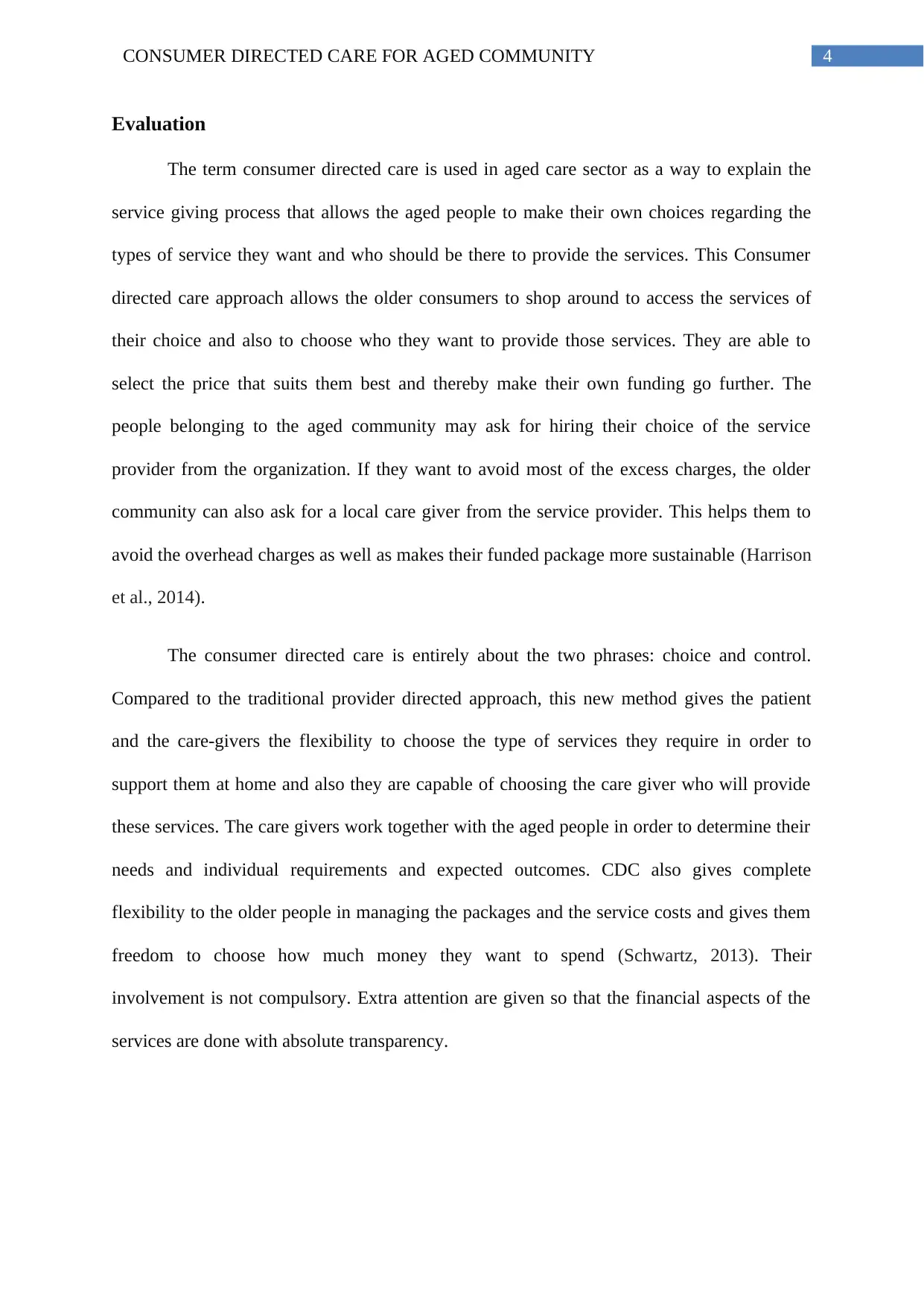
4CONSUMER DIRECTED CARE FOR AGED COMMUNITY
Evaluation
The term consumer directed care is used in aged care sector as a way to explain the
service giving process that allows the aged people to make their own choices regarding the
types of service they want and who should be there to provide the services. This Consumer
directed care approach allows the older consumers to shop around to access the services of
their choice and also to choose who they want to provide those services. They are able to
select the price that suits them best and thereby make their own funding go further. The
people belonging to the aged community may ask for hiring their choice of the service
provider from the organization. If they want to avoid most of the excess charges, the older
community can also ask for a local care giver from the service provider. This helps them to
avoid the overhead charges as well as makes their funded package more sustainable (Harrison
et al., 2014).
The consumer directed care is entirely about the two phrases: choice and control.
Compared to the traditional provider directed approach, this new method gives the patient
and the care-givers the flexibility to choose the type of services they require in order to
support them at home and also they are capable of choosing the care giver who will provide
these services. The care givers work together with the aged people in order to determine their
needs and individual requirements and expected outcomes. CDC also gives complete
flexibility to the older people in managing the packages and the service costs and gives them
freedom to choose how much money they want to spend (Schwartz, 2013). Their
involvement is not compulsory. Extra attention are given so that the financial aspects of the
services are done with absolute transparency.
Evaluation
The term consumer directed care is used in aged care sector as a way to explain the
service giving process that allows the aged people to make their own choices regarding the
types of service they want and who should be there to provide the services. This Consumer
directed care approach allows the older consumers to shop around to access the services of
their choice and also to choose who they want to provide those services. They are able to
select the price that suits them best and thereby make their own funding go further. The
people belonging to the aged community may ask for hiring their choice of the service
provider from the organization. If they want to avoid most of the excess charges, the older
community can also ask for a local care giver from the service provider. This helps them to
avoid the overhead charges as well as makes their funded package more sustainable (Harrison
et al., 2014).
The consumer directed care is entirely about the two phrases: choice and control.
Compared to the traditional provider directed approach, this new method gives the patient
and the care-givers the flexibility to choose the type of services they require in order to
support them at home and also they are capable of choosing the care giver who will provide
these services. The care givers work together with the aged people in order to determine their
needs and individual requirements and expected outcomes. CDC also gives complete
flexibility to the older people in managing the packages and the service costs and gives them
freedom to choose how much money they want to spend (Schwartz, 2013). Their
involvement is not compulsory. Extra attention are given so that the financial aspects of the
services are done with absolute transparency.

5CONSUMER DIRECTED CARE FOR AGED COMMUNITY
Most of the aged care facilities are funded by the Australian government. Only a few are
privately paid by the people and these services are provided by volunteers (Bradley, 2017).
The followings include the government funded initiatives:
Commonwealth home and community care (provides high level of assistance)
Home care packages (provides low level of assistance)
Residential care (provides care in aged care homes or in nursing homes)
This revolutionary reform of consumer directed care in the aged home care industry,
started on 1st July of 2015 and developed into being fully operational since 27th February of
2017. It provides the older citizens of Australia with nine new rights that enables them to
possess more strength than ever before (McCaffrey et al., 2015). Although the consumers
must possess the required knowledge about the rights and always be assertive to receive the
true Consumer Directed Care even if the service providers still wants to impose the
traditional provider directed care on them. The older Australians must therefore acknowledge
the difference between the old and the new rights in order to receive the best care facilities.
Analysis
In Australia the consumer directed care allowed frail senior citizens to possess the
choice of services and control on their life. In January 2012, the outcomes of consumer
directed care showed major improvements in the choices, control and level of satisfaction and
contentment among the clients who have dementia or higher care needs. The cost-
effectiveness of this care has also been proven to be quite impressive (Laragy & Allen, 2015).
Positive aspects of CDC:
The consumer directed care approach provides the chance to close the gap among
different levels of care packages. Thereby the CDC approach benefits the borderline
Most of the aged care facilities are funded by the Australian government. Only a few are
privately paid by the people and these services are provided by volunteers (Bradley, 2017).
The followings include the government funded initiatives:
Commonwealth home and community care (provides high level of assistance)
Home care packages (provides low level of assistance)
Residential care (provides care in aged care homes or in nursing homes)
This revolutionary reform of consumer directed care in the aged home care industry,
started on 1st July of 2015 and developed into being fully operational since 27th February of
2017. It provides the older citizens of Australia with nine new rights that enables them to
possess more strength than ever before (McCaffrey et al., 2015). Although the consumers
must possess the required knowledge about the rights and always be assertive to receive the
true Consumer Directed Care even if the service providers still wants to impose the
traditional provider directed care on them. The older Australians must therefore acknowledge
the difference between the old and the new rights in order to receive the best care facilities.
Analysis
In Australia the consumer directed care allowed frail senior citizens to possess the
choice of services and control on their life. In January 2012, the outcomes of consumer
directed care showed major improvements in the choices, control and level of satisfaction and
contentment among the clients who have dementia or higher care needs. The cost-
effectiveness of this care has also been proven to be quite impressive (Laragy & Allen, 2015).
Positive aspects of CDC:
The consumer directed care approach provides the chance to close the gap among
different levels of care packages. Thereby the CDC approach benefits the borderline
⊘ This is a preview!⊘
Do you want full access?
Subscribe today to unlock all pages.

Trusted by 1+ million students worldwide

6CONSUMER DIRECTED CARE FOR AGED COMMUNITY
consumers by making their transfer of between various levels of funding streams
much more easy.
When the clients start accessing the CDC care packages they become more conscious
and responsible for the service they get and usually do not make any unreasonable
expectations from the care givers (Mittler et al., 2013).
The efficiency of CDC is much more developed regarding its individual budget
control capability. The consumers who have the same requirements possess the same
amount of individual budgets.
Through this modern care approach the consumer’s actual needs are met rather than
what the providers assess about their requirements. Thereby, this greatly promotes the
customer satisfaction.
Each of the care levels consist of a “Dementia care” component. This hugely benefits
the clients, as they do not need to apply for the high care packages to get the special
care for dementia anymore.
Challenges and concerns of CDC:
Sometimes the care givers are unable to fulfil the client’s requirements and
thereby lose the creativity and flexibility which are essential to meet the
consumer’s special needs.
The Consumer directed care requires the aged clients to make the co-payment
individually. This is not an easy task for most of the older citizens. In order to
access services the clients need to access the services otherwise their health would
deteriorate (Crozier et al., 2013).
A decline in the hands-on case management support technique may result in some
difficulties for the clients to access the services themselves. This results in a
decreased quality of services.
consumers by making their transfer of between various levels of funding streams
much more easy.
When the clients start accessing the CDC care packages they become more conscious
and responsible for the service they get and usually do not make any unreasonable
expectations from the care givers (Mittler et al., 2013).
The efficiency of CDC is much more developed regarding its individual budget
control capability. The consumers who have the same requirements possess the same
amount of individual budgets.
Through this modern care approach the consumer’s actual needs are met rather than
what the providers assess about their requirements. Thereby, this greatly promotes the
customer satisfaction.
Each of the care levels consist of a “Dementia care” component. This hugely benefits
the clients, as they do not need to apply for the high care packages to get the special
care for dementia anymore.
Challenges and concerns of CDC:
Sometimes the care givers are unable to fulfil the client’s requirements and
thereby lose the creativity and flexibility which are essential to meet the
consumer’s special needs.
The Consumer directed care requires the aged clients to make the co-payment
individually. This is not an easy task for most of the older citizens. In order to
access services the clients need to access the services otherwise their health would
deteriorate (Crozier et al., 2013).
A decline in the hands-on case management support technique may result in some
difficulties for the clients to access the services themselves. This results in a
decreased quality of services.
Paraphrase This Document
Need a fresh take? Get an instant paraphrase of this document with our AI Paraphraser
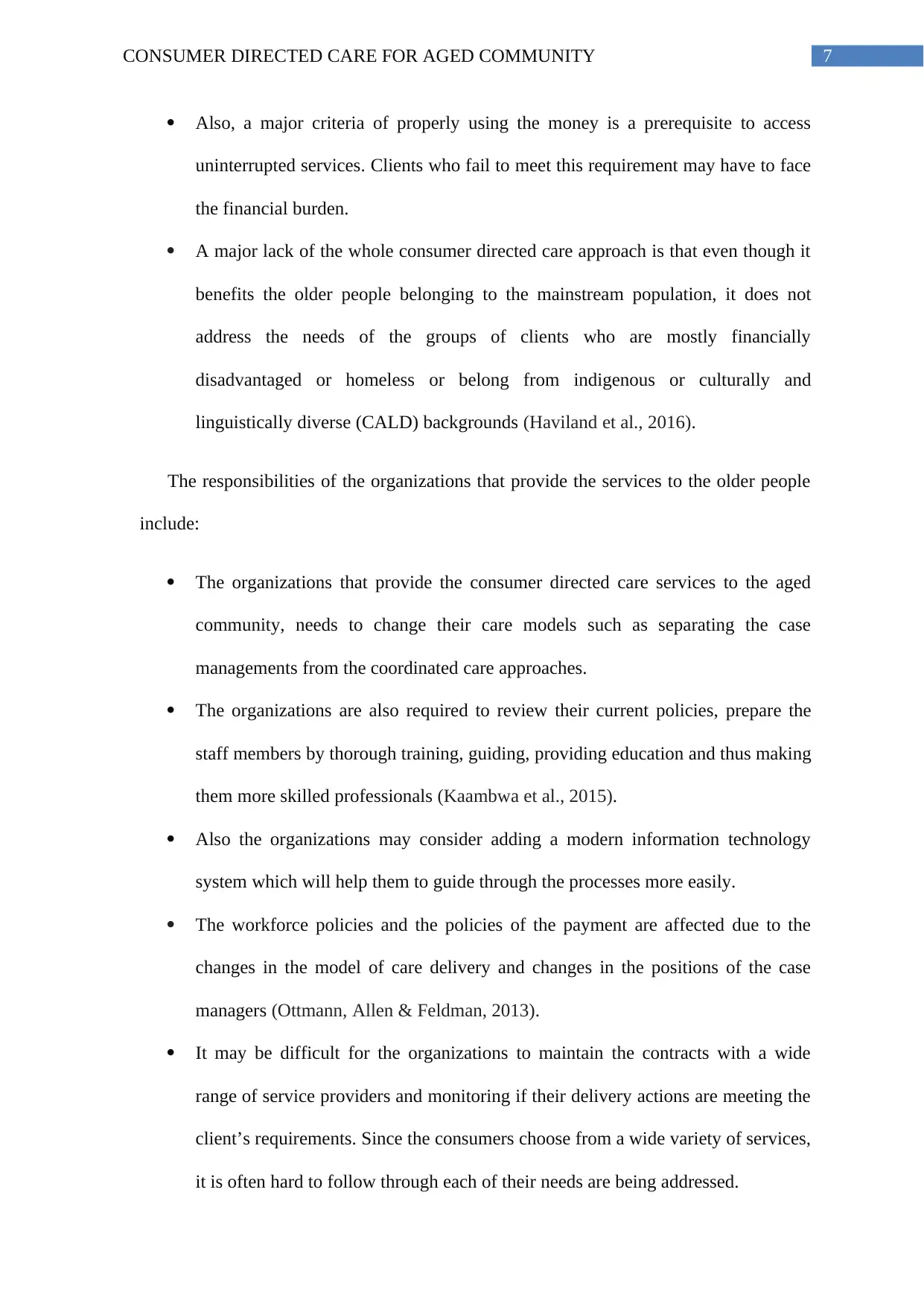
7CONSUMER DIRECTED CARE FOR AGED COMMUNITY
Also, a major criteria of properly using the money is a prerequisite to access
uninterrupted services. Clients who fail to meet this requirement may have to face
the financial burden.
A major lack of the whole consumer directed care approach is that even though it
benefits the older people belonging to the mainstream population, it does not
address the needs of the groups of clients who are mostly financially
disadvantaged or homeless or belong from indigenous or culturally and
linguistically diverse (CALD) backgrounds (Haviland et al., 2016).
The responsibilities of the organizations that provide the services to the older people
include:
The organizations that provide the consumer directed care services to the aged
community, needs to change their care models such as separating the case
managements from the coordinated care approaches.
The organizations are also required to review their current policies, prepare the
staff members by thorough training, guiding, providing education and thus making
them more skilled professionals (Kaambwa et al., 2015).
Also the organizations may consider adding a modern information technology
system which will help them to guide through the processes more easily.
The workforce policies and the policies of the payment are affected due to the
changes in the model of care delivery and changes in the positions of the case
managers (Ottmann, Allen & Feldman, 2013).
It may be difficult for the organizations to maintain the contracts with a wide
range of service providers and monitoring if their delivery actions are meeting the
client’s requirements. Since the consumers choose from a wide variety of services,
it is often hard to follow through each of their needs are being addressed.
Also, a major criteria of properly using the money is a prerequisite to access
uninterrupted services. Clients who fail to meet this requirement may have to face
the financial burden.
A major lack of the whole consumer directed care approach is that even though it
benefits the older people belonging to the mainstream population, it does not
address the needs of the groups of clients who are mostly financially
disadvantaged or homeless or belong from indigenous or culturally and
linguistically diverse (CALD) backgrounds (Haviland et al., 2016).
The responsibilities of the organizations that provide the services to the older people
include:
The organizations that provide the consumer directed care services to the aged
community, needs to change their care models such as separating the case
managements from the coordinated care approaches.
The organizations are also required to review their current policies, prepare the
staff members by thorough training, guiding, providing education and thus making
them more skilled professionals (Kaambwa et al., 2015).
Also the organizations may consider adding a modern information technology
system which will help them to guide through the processes more easily.
The workforce policies and the policies of the payment are affected due to the
changes in the model of care delivery and changes in the positions of the case
managers (Ottmann, Allen & Feldman, 2013).
It may be difficult for the organizations to maintain the contracts with a wide
range of service providers and monitoring if their delivery actions are meeting the
client’s requirements. Since the consumers choose from a wide variety of services,
it is often hard to follow through each of their needs are being addressed.

8CONSUMER DIRECTED CARE FOR AGED COMMUNITY
Conclusion
The people receiving the care addressed this approach of consumer directed care as a
person-centered care which emphasizes and enables the consumers by giving them much
more power, more options to choose from, and control on their needs. This consumer directed
approach also entails the clients to have the entire responsibility for their money and choice
of care. Although it has been mentioned by some consumers that the word “choice”
mentioned in the approach is more of a superficial term. Under many circumstances choosing
the preferred mode of care was not possible and that it turned into the traditional approach of
non-negotiable provider directed care. The organizations that provide these services need to
improve their quality of care in order to satisfy and maintain the customers and increase the
number of clients. Although, the consumer directed care approach has given back the strength
to older people by making their voices heard.
Conclusion
The people receiving the care addressed this approach of consumer directed care as a
person-centered care which emphasizes and enables the consumers by giving them much
more power, more options to choose from, and control on their needs. This consumer directed
approach also entails the clients to have the entire responsibility for their money and choice
of care. Although it has been mentioned by some consumers that the word “choice”
mentioned in the approach is more of a superficial term. Under many circumstances choosing
the preferred mode of care was not possible and that it turned into the traditional approach of
non-negotiable provider directed care. The organizations that provide these services need to
improve their quality of care in order to satisfy and maintain the customers and increase the
number of clients. Although, the consumer directed care approach has given back the strength
to older people by making their voices heard.
⊘ This is a preview!⊘
Do you want full access?
Subscribe today to unlock all pages.

Trusted by 1+ million students worldwide
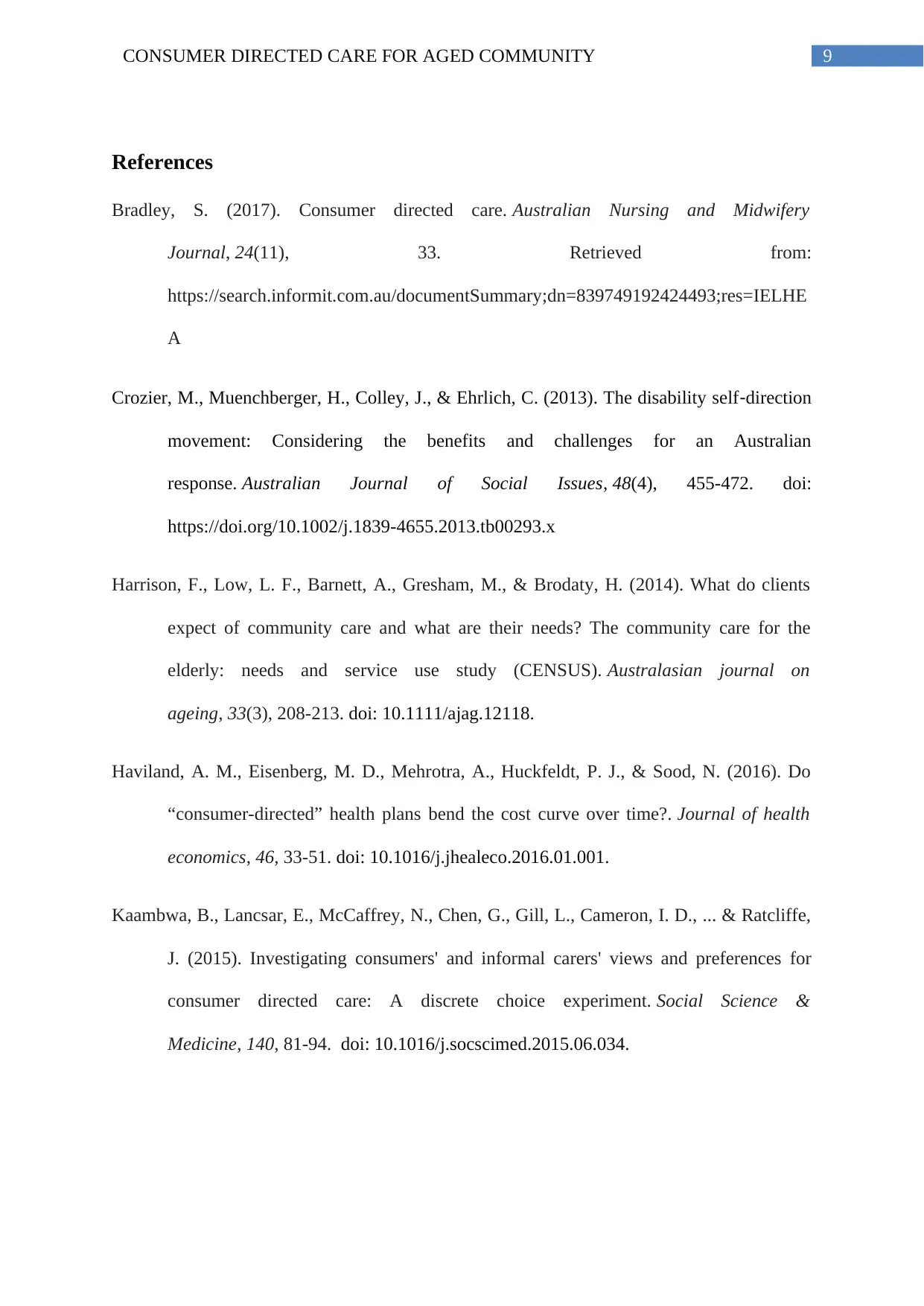
9CONSUMER DIRECTED CARE FOR AGED COMMUNITY
References
Bradley, S. (2017). Consumer directed care. Australian Nursing and Midwifery
Journal, 24(11), 33. Retrieved from:
https://search.informit.com.au/documentSummary;dn=839749192424493;res=IELHE
A
Crozier, M., Muenchberger, H., Colley, J., & Ehrlich, C. (2013). The disability self‐direction
movement: Considering the benefits and challenges for an Australian
response. Australian Journal of Social Issues, 48(4), 455-472. doi:
https://doi.org/10.1002/j.1839-4655.2013.tb00293.x
Harrison, F., Low, L. F., Barnett, A., Gresham, M., & Brodaty, H. (2014). What do clients
expect of community care and what are their needs? The community care for the
elderly: needs and service use study (CENSUS). Australasian journal on
ageing, 33(3), 208-213. doi: 10.1111/ajag.12118.
Haviland, A. M., Eisenberg, M. D., Mehrotra, A., Huckfeldt, P. J., & Sood, N. (2016). Do
“consumer-directed” health plans bend the cost curve over time?. Journal of health
economics, 46, 33-51. doi: 10.1016/j.jhealeco.2016.01.001.
Kaambwa, B., Lancsar, E., McCaffrey, N., Chen, G., Gill, L., Cameron, I. D., ... & Ratcliffe,
J. (2015). Investigating consumers' and informal carers' views and preferences for
consumer directed care: A discrete choice experiment. Social Science &
Medicine, 140, 81-94. doi: 10.1016/j.socscimed.2015.06.034.
References
Bradley, S. (2017). Consumer directed care. Australian Nursing and Midwifery
Journal, 24(11), 33. Retrieved from:
https://search.informit.com.au/documentSummary;dn=839749192424493;res=IELHE
A
Crozier, M., Muenchberger, H., Colley, J., & Ehrlich, C. (2013). The disability self‐direction
movement: Considering the benefits and challenges for an Australian
response. Australian Journal of Social Issues, 48(4), 455-472. doi:
https://doi.org/10.1002/j.1839-4655.2013.tb00293.x
Harrison, F., Low, L. F., Barnett, A., Gresham, M., & Brodaty, H. (2014). What do clients
expect of community care and what are their needs? The community care for the
elderly: needs and service use study (CENSUS). Australasian journal on
ageing, 33(3), 208-213. doi: 10.1111/ajag.12118.
Haviland, A. M., Eisenberg, M. D., Mehrotra, A., Huckfeldt, P. J., & Sood, N. (2016). Do
“consumer-directed” health plans bend the cost curve over time?. Journal of health
economics, 46, 33-51. doi: 10.1016/j.jhealeco.2016.01.001.
Kaambwa, B., Lancsar, E., McCaffrey, N., Chen, G., Gill, L., Cameron, I. D., ... & Ratcliffe,
J. (2015). Investigating consumers' and informal carers' views and preferences for
consumer directed care: A discrete choice experiment. Social Science &
Medicine, 140, 81-94. doi: 10.1016/j.socscimed.2015.06.034.
Paraphrase This Document
Need a fresh take? Get an instant paraphrase of this document with our AI Paraphraser
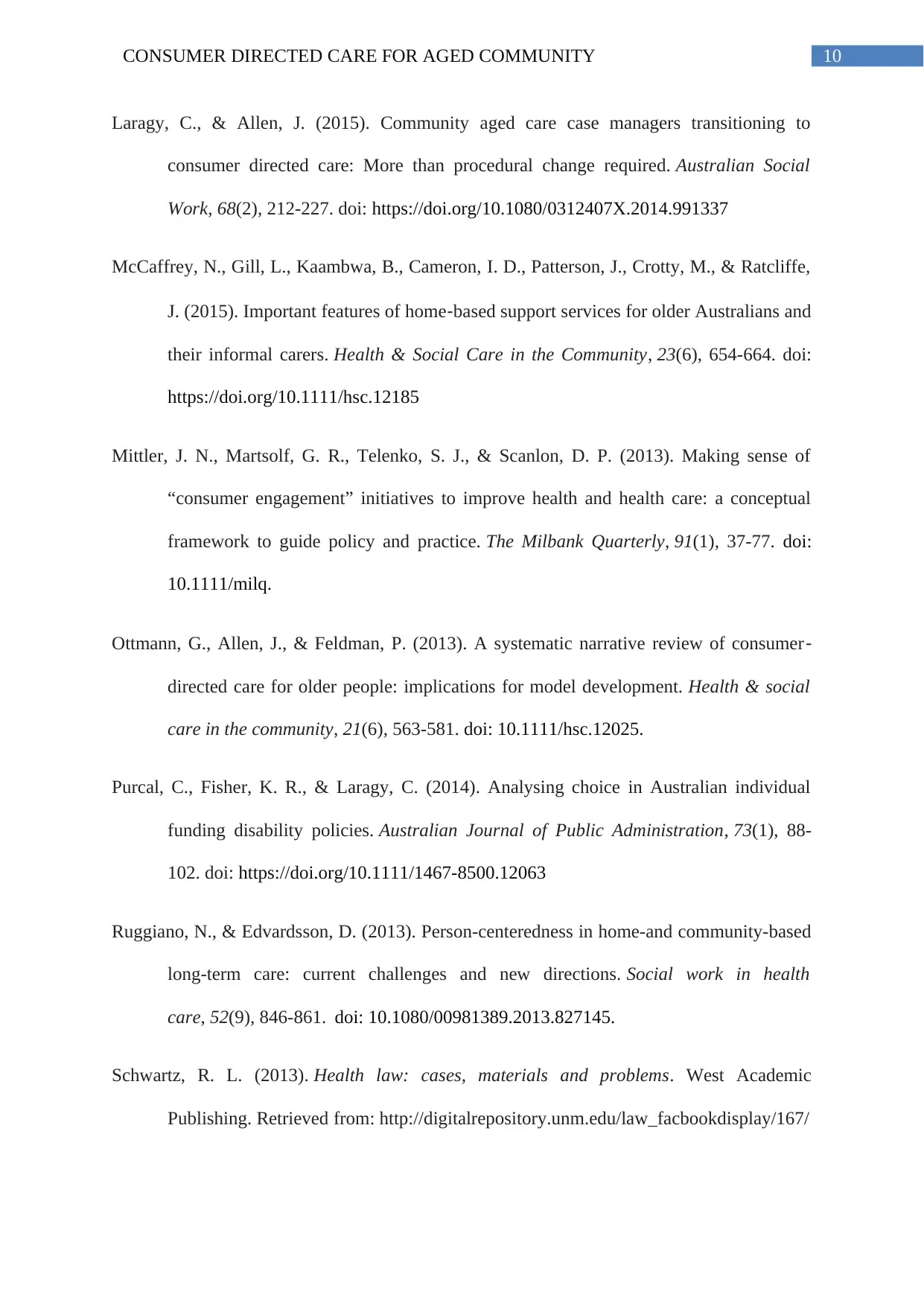
10CONSUMER DIRECTED CARE FOR AGED COMMUNITY
Laragy, C., & Allen, J. (2015). Community aged care case managers transitioning to
consumer directed care: More than procedural change required. Australian Social
Work, 68(2), 212-227. doi: https://doi.org/10.1080/0312407X.2014.991337
McCaffrey, N., Gill, L., Kaambwa, B., Cameron, I. D., Patterson, J., Crotty, M., & Ratcliffe,
J. (2015). Important features of home‐based support services for older Australians and
their informal carers. Health & Social Care in the Community, 23(6), 654-664. doi:
https://doi.org/10.1111/hsc.12185
Mittler, J. N., Martsolf, G. R., Telenko, S. J., & Scanlon, D. P. (2013). Making sense of
“consumer engagement” initiatives to improve health and health care: a conceptual
framework to guide policy and practice. The Milbank Quarterly, 91(1), 37-77. doi:
10.1111/milq.
Ottmann, G., Allen, J., & Feldman, P. (2013). A systematic narrative review of consumer‐
directed care for older people: implications for model development. Health & social
care in the community, 21(6), 563-581. doi: 10.1111/hsc.12025.
Purcal, C., Fisher, K. R., & Laragy, C. (2014). Analysing choice in Australian individual
funding disability policies. Australian Journal of Public Administration, 73(1), 88-
102. doi: https://doi.org/10.1111/1467-8500.12063
Ruggiano, N., & Edvardsson, D. (2013). Person-centeredness in home-and community-based
long-term care: current challenges and new directions. Social work in health
care, 52(9), 846-861. doi: 10.1080/00981389.2013.827145.
Schwartz, R. L. (2013). Health law: cases, materials and problems. West Academic
Publishing. Retrieved from: http://digitalrepository.unm.edu/law_facbookdisplay/167/
Laragy, C., & Allen, J. (2015). Community aged care case managers transitioning to
consumer directed care: More than procedural change required. Australian Social
Work, 68(2), 212-227. doi: https://doi.org/10.1080/0312407X.2014.991337
McCaffrey, N., Gill, L., Kaambwa, B., Cameron, I. D., Patterson, J., Crotty, M., & Ratcliffe,
J. (2015). Important features of home‐based support services for older Australians and
their informal carers. Health & Social Care in the Community, 23(6), 654-664. doi:
https://doi.org/10.1111/hsc.12185
Mittler, J. N., Martsolf, G. R., Telenko, S. J., & Scanlon, D. P. (2013). Making sense of
“consumer engagement” initiatives to improve health and health care: a conceptual
framework to guide policy and practice. The Milbank Quarterly, 91(1), 37-77. doi:
10.1111/milq.
Ottmann, G., Allen, J., & Feldman, P. (2013). A systematic narrative review of consumer‐
directed care for older people: implications for model development. Health & social
care in the community, 21(6), 563-581. doi: 10.1111/hsc.12025.
Purcal, C., Fisher, K. R., & Laragy, C. (2014). Analysing choice in Australian individual
funding disability policies. Australian Journal of Public Administration, 73(1), 88-
102. doi: https://doi.org/10.1111/1467-8500.12063
Ruggiano, N., & Edvardsson, D. (2013). Person-centeredness in home-and community-based
long-term care: current challenges and new directions. Social work in health
care, 52(9), 846-861. doi: 10.1080/00981389.2013.827145.
Schwartz, R. L. (2013). Health law: cases, materials and problems. West Academic
Publishing. Retrieved from: http://digitalrepository.unm.edu/law_facbookdisplay/167/
1 out of 11
Related Documents
Your All-in-One AI-Powered Toolkit for Academic Success.
+13062052269
info@desklib.com
Available 24*7 on WhatsApp / Email
![[object Object]](/_next/static/media/star-bottom.7253800d.svg)
Unlock your academic potential
Copyright © 2020–2025 A2Z Services. All Rights Reserved. Developed and managed by ZUCOL.



